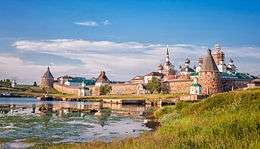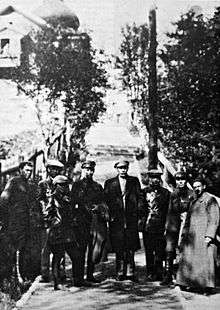Solovki prison camp


The Solovki "special" camp (later the Solovki "special" prison), was set up in 1923 on the Solovetsky Islands in the White Sea as a remote and inaccessible place of detention for socialist opponents of Soviet Russia's new Bolshevik regime. At first the Anarchists, Mensheviks and Socialist Revolutionaries enjoyed a special status there and were not made to work. Gradually prisoners from the old regime (priests, gentry, and White Army officers) joined them and the guards and the ordinary criminals worked together to keep the "politicals" in order.
Aleksandr Solzhenitsyn called Solovki the "mother of the GULAG". It was openly termed a concentration camp until the late 1920s when the euphemism "corrective labour camp" was applied throughout the system, now organised as the GULag or main directorate for corrective-labour camps. The Solovki "special" camp served as a testing ground where security measures were developed and tried out, as were innovations in "living conditions", work production norms, and other forms of repression.
The exact number of prisoners sent to Solovki from 1923 to the closure of its penitentiary facilities in 1939 is unknown. Estimates range between tens and hundreds of thousands.[1] In 1923, Solzhenitsyn thought, Soloviki contained "no more than 3,000" prisoners; by 1930 the number had jumped to "about 50,000", with another 30,000 held at the nearby railroad transit point of Kem.[2]
From monastery to labour camp, and back again
Historically, the Solovetsky Islands were the location of the famous Russian Orthodox Solovetsky Monastery complex. It was a centre of economic activity with over three hundred monks, and also a forepost of Russian naval power in the North, repelling foreign attacks during the Time of Troubles, the Crimean War, and the Russian Civil War.
Lenin's unpublished decree of 3 November 1923 led to the conversion of the monastery buildings into the Solovki "special" camp or Solovetsky Lager' Osobogo Naznachenia (SLON).[3] (The acronym is a play on the Russian word "slon" meaning elephant.) One of the first "forced labor camps", Solovki served as a prototype for the Gulag as a whole.[4] In early 1924 it was sometimes given a double name, Severnye (Solovetskiye) Lagerya OGPU (Northern (Solvki) camps of OGPU).[5]

In 1926 the Solovki camp was turned into a prison, partly because of the conditions which made escape near-impossible and partly because the monastery had previously been used, on occasion, as a political prison by the Russian imperial administration. The treatment of the prisoners attracted much criticism in Western Europe and the USA. After a thorough clean-up, the Soviet government sent the proletarian writer Maxim Gorky to the camp in an attempt to counter this criticism. He wrote a very favourable essay, which praised the beauty of nature on the islands, but some authors believe he understood the real conditions he was witnessing.[6][7]
The Baltic-White Sea Canal
In the early 1930s many of the prisoners from the camp worked on the notorious White Sea – Baltic Canal,[6] one of a succession of grandiose schemes devised by Stalin.
During the Great Purges over 9,500 victims of Soviet political repressions were executed by shooting from 11 August 1937 to 24 December 1938 and buried on the mainland at Sandarmokh, near the first two locks of the canal. More than a thousand of those shot were transported to the mainland from Solovki and were long thought to have died from drowning after the barge on which they were travelling was deliberately sunk in the White Sea.[8] The 1,111 prisoners from Solovki were executed by NKVD Capt. Mikhail Matveyev over a four-day period in November 1937.[9]
In 1939, the prison was closed. It was situated too close to the border with Finland, and the Second World War was imminent. The buildings were transformed into a naval base and a cadet corps was deployed there, one of its students being the future author Valentin Pikul.
A World Heritage site
The Orthodox Church reestablished the monastery in 1992, the year when the ensemble was included into UNESCO's World Heritage List. In 2015 human rights activists accused the authorities of "gradually removing all traces of the labor camp".[10]
Notable prisoners


Many prisoners were members of the intelligentsia, and represent the cream of Tsarist and revolutionary-period Russia. These include:[11]
- Alexander Anisimov (ru:Анисимов, Александр Иванович (искусствовед))- art restoration expert and art historian
- Nikolai Antsiferov – historian
- Vladimir Artemyev – inventor
- Sergei Askoldov (alias S. Alekseev, born Sergei Alekseyevich Kozlov), philosopher and theologian
- Vladimir N. Beneshevich – historian, paleographer
- A.V.Bobrishev-Pushkin – descendant of Decembrist Pavel Sergeievich Bobrishev-Pushkin
- Osip Braz – Russian-Jewish realist painter
- Leonid Feodorov – Bishop and Exarch of the Russian Greek Catholic Church.
- Pavel Alexandrovich Florensky – priest, scientist, encyclopaedist
- Konstantine Gamsakhurdia – Georgian writer
- G.J.Gordon – historian
- A.K.Gorsky – poet
- Archimandrite Illarion (Troitsky, ru:Иларион (Троицкий)) – Professor of the Moscow Theological Academy
- Academician Dmitry Sergeyevich Likhachov – philologist
- Mirjaqip Dulatuli- Kazakh writer
- I.V. Popov – Professor of the Moscow Theological Academy
- Varlam Shalamov – writer
- Vladimir V. Tchernavin – ichthyologist
- H.H.Vinogradov – ethnographer
- Oleg V. Volkov – writer
- M.N.Voronoy – poet
- Jamo bey Hajinski – State Controller and Minister of Transportation, Postal Service and Telegraph of Azerbaijan Democratic Republic
- Nariman bey Narimanbeyov – State Controller of Azerbaijan Democratic Republic
- Hamid bey Shahtakhtinski – Minister of Education and Religious Affairs of Azerbaijan Democratic Republic
- Karlo Štajner - a Yugoslavian communist
Naftaly Frenkel was at first a prisoner, but later became commander of the camp.
Solovki camp in art and literature

Emigré and samizdat literature, 1926-1974
- Malsagoff, S.A. (1926). An Island Hell: a Soviet prison in the Far North. London: A.M. Philpot. The first memoir about Solovki was by S.A. Malsagoff, a North Caucasian prisoner, who escaped after a year on the islands.
- Bessonov, J.D. (1929). My 26 prisons and my escape from Solovetsky. London: Jonathan Cape.
- Tchernavin, Vladimir V. (1934). I speak for the silent prisoners of the Soviets. Tchernavin was a prisoner in the camp in the early 1930s. He described his experiences there in his book,[12] published after his escape abroad.
- Bulgakov, Mikhail (1940). The Master and Margarita. Ivan Ponyrov, the poet also known as "Ivan the Homeless", suggests to Woland (a German name for Satan) that Immanuel Kant should be sent to Solovki as punishment for his attempts to prove the existence of God. Woland replies
"Thats just the place for him! I told him so that day at breakfast...[However] It is impossible to send him to Solovki for the simple reason that he has resided for the past hundred-odd years in places considerably more remote than Solovki, and, I assure you, it is quite impossible to get him out of there."
- The fictional town of Solovets in the Strugatsky brothers' popular Monday Begins on Saturday (1965) is an allusion to the Solovetsky Monastery.
- Aleksandr Solzhenitsyn (1975). The Gulag Archipelago. Collins & Harvill Press. Solzhenitsyn spends an entire chapter of Volume 2 discussing the development of Solovki and conditions there during the early years of the Soviet regime.
Perestroika and Glasnost, 1985-1991
- Marina Goldovskaya's 1987 documentary film The Solovki Regime («Власть Соловецкая») tells the story of the islands and their status as the first, permanent camp in Soviet Russia. It includes interviews with former prisoners, among them mediaevalist Dmitry Likhachyov, writer Oleg Volkov and long-term Gulag inmate Olga Adamova-Sliozberg (who was one of the four named sources in Solzhenitsyn's Gulag Archipelago).
- Vilensky, Simeon (ed.) (1999). Till my Tale is Told: women's memoirs of the Gulag. Bloomington: Indiana University Press. ISBN 0-253-33464-0. Abridged version of the 1989 Soviet original («Доднесь тяготеет. т. 1. Записки Вашей современницы»).
- Yugoslav communist Karlo Stajner served a part of his sentence on Solovki. He described his experiences there in 7,000 days in Siberia (English edn. 1989).[13]
Footnotes
- ↑ "Forced Labor Camps", on-line exhibition at the Open Society Archives.
- ↑ Aleksandr Solzhenitsyn (1975). The Gulag Archipelago. Collins & Harvill Press. p. 72.
- ↑ Соловецкий Лагерь Особого Назначения (СЛОН). (in Russian)
- ↑ Gulag by Anne Applebaum. New York: Anchor Book, 2003. p.20.
- ↑ СОЛОВЕЦКИЙ ИТЛ ОГПУ (Соловецкие лагеря особого назначения, Соловецкий лагерь принудительных работ особого назначения ОГПУ, СЛОН, СЛАГ, Соловецкие и Карело-Мурманские лагеря, СКМИТЛ) Memorial (in Russian)
- 1 2 Robson, Roy R. (2004). Solovki: The Story of Russia Told Through Its Most Remarkable Islands. Yale University Press. p. 320. ISBN 9780300102703. See pp. 242–243.
- ↑ Yedlin, Tova (1999). Maxim Gorky: A Political Biography. Greenwood Publishing Group. p. 260. ISBN 9780275966058. See p.188.
- ↑ "Sandarmokh"
- ↑ Fishman, Mikhail (9 June 2017). "Stalin's Shadow: How a Gulag Historian Fell Victim to Russia's Dark Past". The Moscow Times. Retrieved 2017-06-12.
- ↑ Macfarquhar, Neil (2015-08-30). "A Tug of War Over Gulag History in Russia’s North". The New York Times. ISSN 0362-4331. Retrieved 2015-08-31.
- ↑ Application for UNESCO World Heritage Site, 1991, p. 11.
- ↑ I speak for the silent prisoners of the Soviets (1934).
- ↑ 7,000 days in Siberia (1989).
Further reading
- Adamova-Sliozberg, Olga (1999). "My Journey". Till My Tale is Told: 28–34.
- Ascher, Abraham (July 1969). "The Solovki prisoners, the Mensheviks and the Socialist International". Slavonic and East European Review. 47 (109): 423–435.
- Babina-Nevskaya, Berta (1999). "My First Prison, February 1922". Till My Tale is Told: 97–111.
- Baron, Nick (Jan–Mar 2002). "Production and terror: the operation of the Karelian Gulag, 1933-1938". Cahiers du monde russe. 43 (1): 139–180.
- Galina Mikhaĭlovna Ivanova, Carol Apollonio Flath, and Donald J. Raleigh, Labor Camp Socialism: The Gulag in the Soviet Totalitarian System. New York: M.E. Sharpe, 2000.
- Michael Jakobson, Origins of the GULAG: The Soviet Prison Camp System, 1917–1934. Lexington, KY: University Press of Kentucky, 1993.
- Roy P. Robson, Solovki: The Story of Russia Told Through its Most Remarkable Islands. Cambridge, MA: Yale University Press, 2004.
- Vladimir V. Tchernavin, I Speak for the Silent: Prisoners of the Soviets. Boston: Hale, Cushman, and Flint, 1935.
External links
| Wikimedia Commons has media related to Solovki prison camp. |
- Forced Labor Camps, Open Society Archives, www.osa.ceu.hu/
Coordinates: 65°1′28″N 35°42′38″E / 65.02444°N 35.71056°E